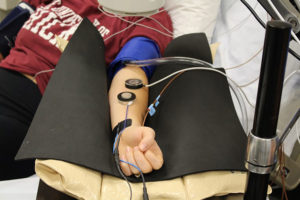Simple use of blood pressure cuff could reduce heart attack risk

AMES — When you visit the doctor’s office, someone will usually check your height, weight, and blood pressure.
New research from Iowa State University finds that last simple procedure could help to reduce the risk of a heart attack or stroke. Jim Lang, an ISU professor of kinesiology, says they put a blood pressure cuff on test patients for five minutes or so and did that three or four times — with surprising results.
“That improved microvascular function, that improved small blood vessel function in the skin and in other places besides where the blood pressure cuff was administered,” Lang says, “and we actually increased microcirculatory capacity by about 50%.” Much the way exercise helps muscles adapt to more strenuous workouts, studies find that short, repeated bouts of reduced circulation with a blood pressure cuff may help reduce tissue damage and prevent the worst outcomes of heart attacks and strokes.
The research finds people who’ve survived a heart attack or stroke may benefit from routine use of a blood pressure cuff, and it could also have positive impacts on people with diabetes and other ailments. “People that are immobilized or people that have joint issues and so forth that really prevent them from being able to do much exercise, this could be a benefit to them,” Lang says. “And I’m not going to say it’s a substitute for exercise, but it’s an additional intervention that could be a benefit.”
A decent blood pressure cuff only costs about $25 and Lang says the study suggests this do-it-yourself, non-invasive procedure can boost vascular and cardiac functions, modestly lower blood pressure and reduce the heart’s workload.
“There’s a lot of different types of avenues that this type of intervention could go towards,” Lang says. “Again, it’s a very simple intervention. It doesn’t require any type of pharmacological component. It’s just simply inflating a blood pressure cuff on a limb.”
Using the cuff could benefit someone preparing for an upcoming surgery, people who are pre-hypertensive or who have sleep apnea, Lang says, adding, even astronauts could find the procedure as an effective supplement to their workouts in orbit. Lang’s study was recently published in the Journal of Physiology.




